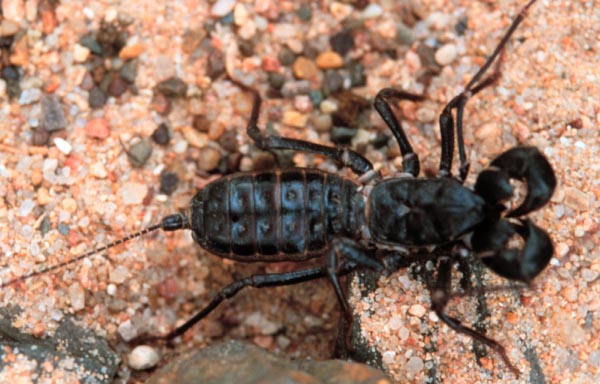
“Vinegaroon”, Mastigoproctus giganteus (Lucas) (Uropygi: Thelyphonida).
Photo by Drees.
Common Name: Vinegaroon
Scientific Name: Mastigoproctus giganteus (Lucas)
Order: Uropygi
Description: Vinegaroons have heavy mouthparts (pedipalps) that are formed into pincers. The first pair of legs is long and thin and is used like antenna to feel their way around. The next three pairs of legs are used for walking. The abdomen is attached widely to the head-thorax region (cephalothorax). The tail is long and thin suggesting a whip which is where the common name, “whipscorpion,” originates for the order Uropygi. The only species that occurs in Texas is Mastigoproctus giganteus (Lucas) which is a vinegaroon in the family Thelyphonidae. Our Texas species is nearly black in color. Bodies of adults are 1 1/2 to 3 inches long. It is found primarily in west Texas especially in the Trans-Pecos region, but has been reported as far north as the Panhandle and in south Texas.
Life Cycle: Eggs are carried in a sac by the female. After hatching, they ride on the female’s back similar to scorpions.
Habitat, Food Source(s), Damage: Mouthparts are for chewing. Vinegaroons are nocturnal and have poor vision, relying on sensing vibrations to locate prey. They are more commonly found in desert areas but they have also been reported in grassland, scrub, pine forests, and mountains.
Pest Status: Considered non-poisonous but they can pinch; capable of spraying a mist from scent glands at the base of the tail when disturbed. The mist produced by our species contains 85% concentrated acetic acid or vinegar, hence the name “vinegaroon.”
For additional information, contact your local Texas A&M AgriLife Extension Service agent or search for other state Extension offices.
Literature: Borror, Triplehorn & Johnson 1989; Levi et al. 1990; Rowland & Cooke 1973.